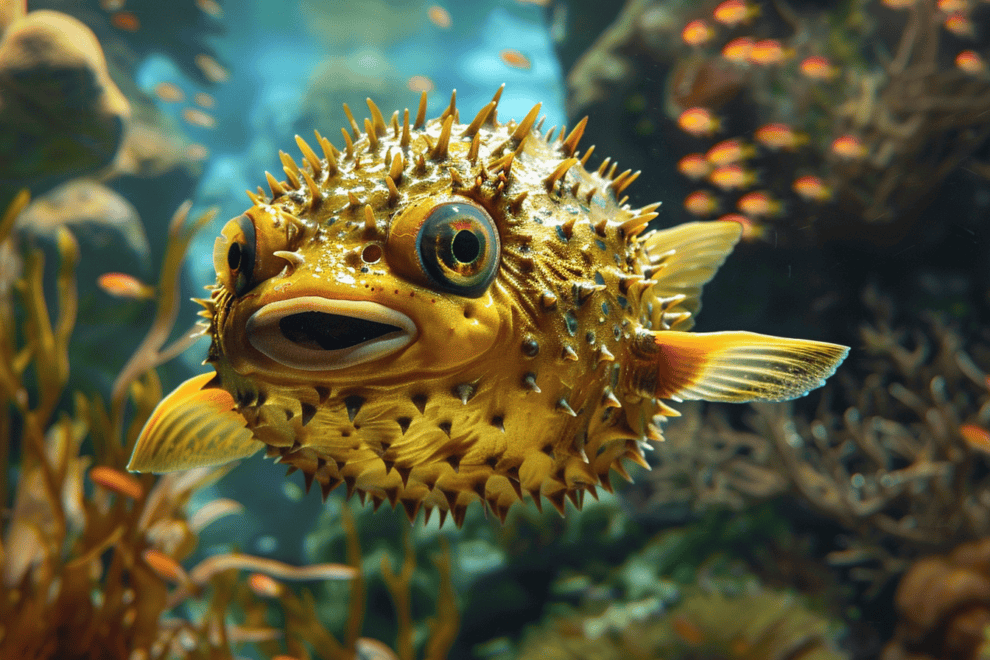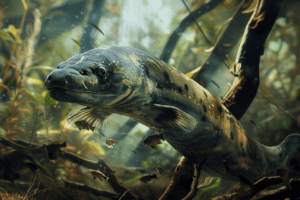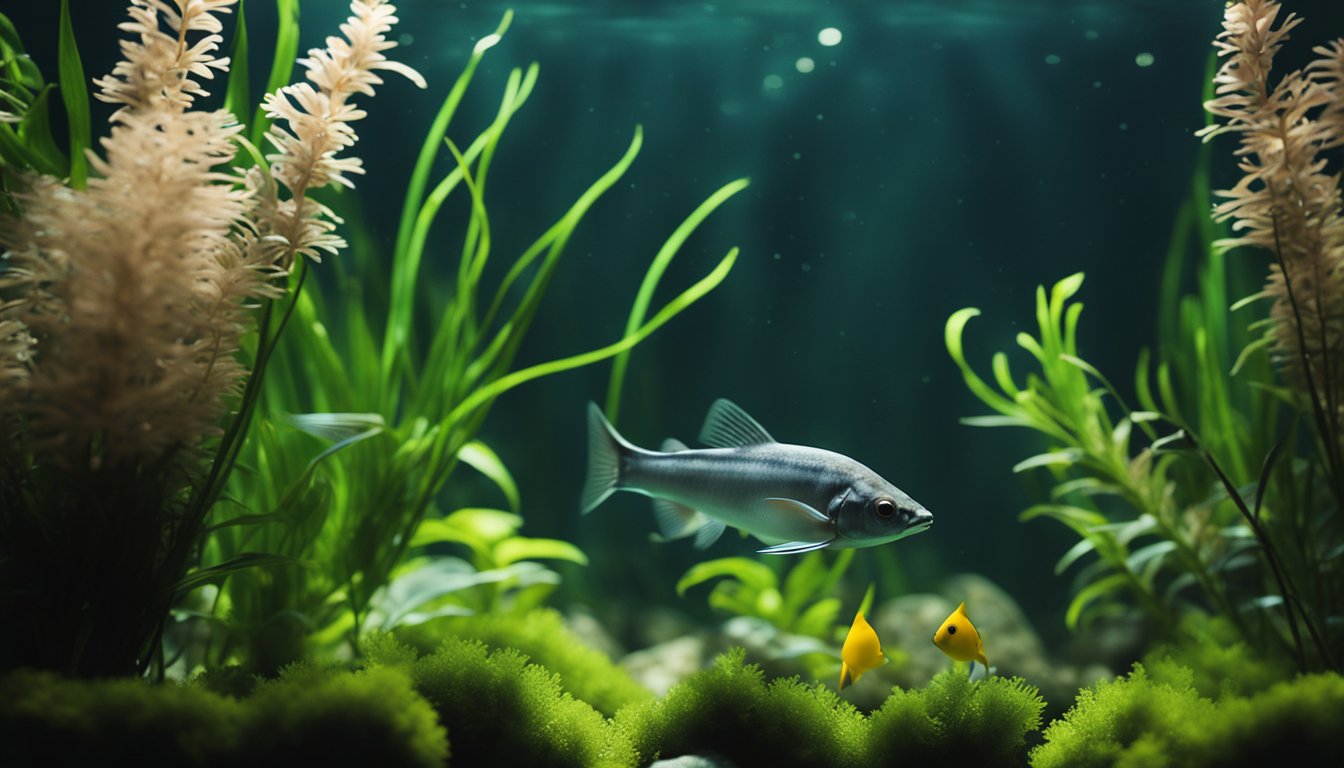Pufferfish are fascinating creatures that can inflate their bodies by gulping water, transforming into spiky, spherical shapes to ward off predators.
Their defense doesn’t stop there; they also harbor tetrodotoxin, a powerful neurotoxin that can be lethal in tiny amounts. This deadly toxin blocks essential nerve signals, making pufferfish dangerous to touch or eat.
Remarkably, pufferfish themselves are immune to tetrodotoxin, thanks to a genetic mutation. While these fish are a delicacy in some cuisines, improper preparation can be fatal.
How Do Pufferfish Inflate?

When threatened, pufferfish gulp water into a special sack near their bellies to inflate themselves. This remarkable ability allows them to increase their body size up to three times, making it much harder for predators to swallow them.
The pufferfish’s elastic stomachs can stretch considerably, accommodating the influx of water. Their spiky skin, particularly in Diodontidae pufferfish, adds an extra layer of defense, turning their bodies into a formidable, spiny sphere.
Pufferfish inflate using specially modified gill muscles and a notable lack of ribs, which lets them swell into an almost spherical shape. These inflatable creatures can even gulp in air if they’re out of the water, maintaining their defense mechanism on land.
However, inflating isn’t without its costs. When inflated, pufferfish rely heavily on their gills, consuming up to five times more oxygen than when at rest. This increased demand for oxygen can lead to significant oxygen debt, making it difficult for them to swim while inflated.
Thus, while the pufferfish’s ability to inflate provides an effective defense, it also places a considerable strain on their bodies, highlighting the delicate balance between survival and energy expenditure.
Tetrodotoxin Defense Mechanism

Tetrodotoxin (TTX) serves as a potent neurotoxin in pufferfish, providing them with a powerful and effective defense against predators.
This deadly toxin is so lethal that just 250-300 micrograms can kill an adult human. Pufferfish carry enough TTX to kill 30 adults, with the highest concentrations found in their liver, ovaries, skin, and intestines.
TTX works by binding to nerve cells and blocking essential signals between the brain and the body. This disruption makes it an extremely effective defense mechanism. Predators that dare to eat a pufferfish are quickly incapacitated by the neurotoxin, often leading to death.
Interestingly, pufferfish themselves are immune to this deadly poison. Due to a genetic mutation, they can safely synthesize TTX from bacteria in their food without suffering any ill effects. This immunity is crucial, allowing them to wield such a potent toxin without self-harm.
Adding to its effectiveness, there’s no known antidote for TTX poisoning. This makes the neurotoxin a highly effective deterrent. The lethal nature of TTX ensures that predators think twice before targeting a pufferfish, securing the fish’s survival in the wild.
Pufferfish as Food

Despite its deadly potential, pufferfish is considered a delicacy in several cuisines around the world. Known as fugu in Japan, this dish is highly prized for its unique flavor and texture.
However, it’s essential to remember that pufferfish contain a deadly toxin called tetrodotoxin, which is far more poisonous than cyanide. Just a tiny amount of this toxin can be enough poison from a single pufferfish to kill 30 adult humans.
Because of this, the preparation of pufferfish is strictly regulated. Only specially trained and licensed chefs are allowed to handle and serve it, ensuring that the toxin is removed correctly. Unauthorized use or improper preparation can lead to fatal consequences.
Pufferfish are typically found in tropical and subtropical ocean waters. Despite their popularity as a delicacy, they’re considered vulnerable due to overfishing and habitat loss.
It’s fascinating yet sobering to think that something so dangerous can also be so desirable. When consuming pufferfish, you’re engaging with a culinary tradition that balances on the edge of life and death, making it a unique experience that few other foods can offer.
Natural Habitat

Beyond their culinary allure, pufferfish thrive in diverse environments, from tropical and subtropical ocean waters to brackish and freshwater habitats.
These unique fish are found worldwide, inhabiting the vibrant coral reefs of the Atlantic and the secluded marshes of warm regions. You’ll find them in the tropical waters of Japan, where the famous fugu resides, and in the brackish zones where rivers meet the sea.
Pufferfish aren’t limited to salty waters; some species adapt to freshwater environments. They can be found in rivers and lakes, like the Congo River basin and Lake Tanganyika.
Freshwater species such as the arrowhead, dwarf, Mbu, and Nile pufferfish, along with the spotted Congo puffer, bring diversity to their habitats. These environments provide plenty of cover, essential for their survival.
However, pufferfish face challenges due to habitat loss. Destruction of coral reefs and pollution in rivers and lakes threaten their natural homes.
Warm waters are essential for their thriving, and any changes in temperature or environment can profoundly impact their populations. By understanding their habitats, you gain insight into the delicate balance needed to preserve these fascinating creatures.
Dietary Habits

Pufferfish have a diverse diet, primarily feasting on invertebrates and algae.
In the wild, they munch on a variety of invertebrates like mollusks, which include clams and mussels. They use their beak-like mouth with four fused teeth to crack open these hard shells and enjoy the tasty insides.
Their diet also includes other invertebrates such as sea sponges and coral, providing them with a rich source of nutrients.
To maintain a balanced diet, pufferfish also consume algae and seaweed, which contribute to their overall health. This combination of plant and animal matter guarantees they get the necessary vitamins and minerals.
In captivity, their dietary needs are quite similar. You’ll need to offer them a mix of meaty foods like brine shrimp and mysis shrimp, along with some chopped fish.
Don’t forget to include vegetable matter like algae and seaweed to mimic their natural eating habits.
Interestingly, the bacteria in their diet are believed to help pufferfish synthesize their deadly tetrodotoxin, making them immune to its effects.
With such a varied and thriving diet, pufferfish thrive in their natural habitats and in aquariums alike.
Survival Threats

While their varied diet helps them thrive, pufferfish face several survival threats in their natural habitats.
Despite their formidable tetrodotoxin defense, they’re still vulnerable to numerous dangers.
Pollution is a significant concern, as contaminants in subtropical ocean waters, brackish environments, and freshwater ecosystems can severely impact pufferfish populations. Industrial waste, plastic debris, and chemical runoff poison their habitats, diminishing their chances of survival.
Predators also pose a threat, albeit a lesser one due to the pufferfish’s toxic defense. Still, larger fish, sharks, and even humans, who often seek them for the delicacy fugu, can reduce their numbers.
Overfishing exacerbates this issue, leading to the decline of pufferfish in certain regions.
Habitat destruction further threatens these unique fish. Coastal development, mangrove deforestation, and coral reef degradation strip pufferfish of their homes, making it difficult for them to find shelter and reproduce.
Climate change also plays a role, altering water temperatures and salinity levels, which can affect their survival.
Despite their resilience and adaptability, pufferfish populations are increasingly at risk.
Understanding these threats is vital for conservation efforts, ensuring these fascinating creatures continue to thrive in their natural environments.
Frequently Asked Questions
How Do Pufferfish Reproduce?
Pufferfish reproduce during spawning season. You’ll observe fascinating courtship rituals. Males establish territories, build nests, and provide parental care. Eggs undergo incubation, leading to fry development. The larval stage occurs in protected breeding grounds.
What Are the Different Types of Pufferfish?
You’re curious about the different types of pufferfish. They exhibit species diversity, varying in size, color patterns, and diet. Their habitat preferences and geographic distribution influence migration patterns. Evolutionary traits and conservation status also play significant roles.
How Long Do Pufferfish Live?
Pufferfish’s lifespan variability depends on environmental factors like diet, water quality, and tank size. Predatory threats and stress impacts can shorten their aging process. Good habitat influences growth rate and health indicators, enhancing survival tactics and longevity.
Can Pufferfish Be Kept as Pets?
Yes, you can keep pufferfish as pets, but you’ve got to guarantee proper tank size, water parameters, diet requirements, and filtration needs. Be mindful of tank mates, handling precautions, breeding challenges, stress factors, and species compatibility.
What Unique Behaviors Do Pufferfish Exhibit?
You’ll notice pufferfish exhibit unique behaviors like their inflation mechanism and defensive posture when threatened. They show distinct habitat preferences, specific feeding habits, intriguing social interactions, color changes, nocturnal activity, territorial behavior, and notable stress responses.








